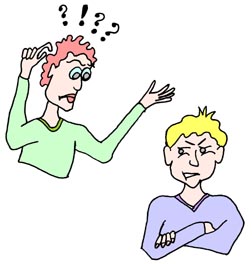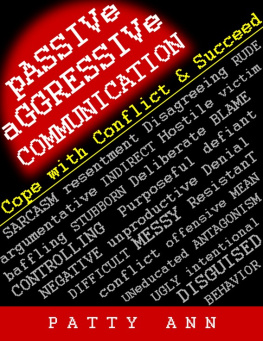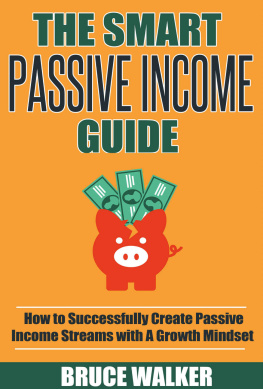PASSIVE-AGGRESSIVECOMMUNICATION
Cope with Conflict & Succeed
This Book Completely
Written, Illustrated & Designed
by Patty Ann
Published by Patty Ann atSmashwords
Copyright 2013 PattyAnn
ISBN9781311971746
Smashwords Edition,License Notes
This ebook is licensed foryour personal enjoyment only. This ebook may not be re-sold orgiven away to other people. If you would like to share this bookwith another person, please purchase an additional copy for eachrecipient. If youre reading this book and did not purchase it, orit was not purchased for your use only, then please return toSmashwords.com and purchase your own copy. Thank you for respectingthe hard work of this author.
All RightsReserved
No part of this book may bereproduced, stored in or introduced into a retrieval system, ortransmitted, in any form or by any means (electronic, mechanical,photocopying, recording or otherwise) without the prior writtenpermission of the author. Thank you.
Note to Teachers & Industry Educators! Would you likeunlimited copying rights to these books year round? You can haveyour organization lease these handbooks for your workplace at anominal cost. Additionally, full size printable PDF books are available for all ofPatty Ann's books. Please visit PattyAnn.net for furtherdetails.
ChapterHighlights
Chapter Titles are Hyper-linked
Types of Passive-AggressiveMessages
- Whydo people use passive-aggressivebehaviors?
- How to stop passive-aggressive behavior cycles
Perception Checks ClarifyMisunderstandings
- What is Conflict?
- The Facts of Conflict
- Use"I" Statements
- Confront the Issues
- Find Solutions
- Identify and Communicate YourNeeds
- Listen to Others
- Share Problem-ResolutionResponsibilities
Welcome to
PASSIVE-AGGRESSIVECOMMUNICATION
Cope with Conflict & Succeed

Passive-Aggressive Behavior
Communication comes in all formsand is essential to every type of living being on this earth.Identifying behaviors is an important part of communicating.Without this skill successful interactions would notoccur.
We all come from backgrounds wherewe learned behaviors that are deeply embedded in our psyche. Noneof us came with an instruction manual on how to talk to ourparents, friends, peers, supervisors and others. We learned alittle along the way and made the best of our situations that ourknowledge allowed.
This booklet takes a look at oneof the most prevalent communication conditions. Passive-aggressivemessages are not only challenging, but are extremely difficult torecognize when attempting to find understanding between twoparties.
In other words passive-aggressivebehavior is one of the most difficult communication patternsbecause the behavior is hard to pick out and often baffling toremedy.
This guidebook will help you learnhow passive-aggressive behaviors are expressed, and what behaviorsto observe. Best of all you will learn simple techniques on how tocope with this type of conflict successfully.
Typesof Passive-Aggressive Messages

Passive-aggressive messages areanti-productive behaviors that develop when communication betweentwo people is not honest and straightforward. These behaviors areused to gain control in a relationship when one person perceivesthey have lost their ground.
What does passive-aggressivebehavior look like? Typically, it's when a person showsdissatisfaction to another individual by disguising theirunhappiness through undesirable behaviors.
Make no mistake!Passive-aggressive action IS communication. Look at it thisway:
Passive-aggressive = 10% words +90% actions
Example:
Your good friend stomps aroundwhen she is mad at something you've done. Instead of confrontingyou about what upsets her, she throws a tantrum. This tactic straysyou for the moment, but the real underlying problem goesunresolved.
Example:
You are mad at your parents forthe curfew they instituted. Instead of discussing alternatives withthem you lash out with a bad temper. Acting out instead ofcommunicating directly is a form of passive-aggressivebehavior.
A person that usespassive-aggressive behavior has learned to deal with conflictindirectly. Here are some examples:
Guilt: "Don't worry about me; go have a good time." Or, "Forget it,I'll do it myself."
Using Hints: "I wonder when the car is going to get fixed."
Sarcasm: Using humor and/or laughing to avoid confrontation. Dumbestidea ever. Think smarter!
Body Language: Rolling your eyes, sighing loudly, or curling your lip duringa conflict shows resentment and asks for an argument.
Why do people usepassive-aggressive behaviors?
(1) Somefolks are not fully aware that their behavior is passive-aggressivebecause they learned this way of communicating from their parentsor mentors. It is a built-in habit.
(2) Others know exactly how to utilize passive-aggressivebehavior to accomplish getting what they want from someone else.Because this type of communication is not straightforward, but donein a very ambiguous way, passive-aggressive behavior is also knownas 'crazy making'.
There are a number of drawbacks tousing a passive-aggressive approach, which include:
* Passive-aggressive behaviors do not work as a long termsolution.
* Due tothe indirect nature of passive-aggressive behavior your counterpartmay completely misunderstand your message.
* Thevictim of your behavior may understand your message, but refuse tocomply.
* Passive-aggressive communication irritates yourcounterpart.
* Ultimately this behavior builds a resentful climate and harmsa relationship.
How to stop passive-aggressivebehavior cycles
First, you must be able to recognize passive-aggressive behavior.
Second, getting to the root ofcommunication problems is in understandingbehavior patterns .
Three steps can help:
(1) Asking questions to clarify what was said;
(2) Paraphrase back what you think you heard;
(3) Use empathy to understand the other person's viewpoint.
These are essential skills topractice that will pave your way towards finding common ground,building stronger relationships, and coping with passive-aggressivebehaviors.
If you recognizepassive-aggressive activities in your relationships confront yourother half about their behavior.
However, be prepared forunexpected reactions due to the unpredictable nature of thisconduct. Tread lightly, be respectful, and use perception checks to gainunderstanding. What is a perception check? Read on...
Perception Checks ClarifyMisunderstandings
Nobody can read another person'smind, but you do have the ability to learn more about what anotherperson is thinking. The skill of 'perception checking' provides away to share your interpretations and enable a commonunderstanding. Perception checks have 3 parts:
* Adescription of the behavior you noticed;
* Severalpossible interpretations of the behavior;
* Arequest for clarification, or an explanation, about how you shouldinterpret the behavior.
'Perception checks' serve a veryimportant function during the communication process. It allows youto become aware of another person's viewpoint, which helps you tounderstand the reason for their actions. Practicing 'perceptionchecks' routinely will make you more aware of what other people say(the content) and the meanings intended behind what they say (therelational aspect).
Next page











